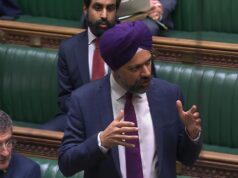Correction: A previous version of this article stated that the Government had set a target to increase defence spending to 3 percent of GDP by 2030. This was based on a written parliamentary answer that has since been corrected.
The Government has stated an ambition to increase defence spending to 3 percent of GDP during the next Parliament, according to a corrected written parliamentary answer that reflects evolving UK defence planning.
In response to a question from Jim Shannon MP, Defence Minister Maria Eagle initially said the Government aimed to reach the 3 percent threshold by 2030. However, this was later corrected. The updated answer now reads: “The Government is firmly committed to increasing defence spending to reach 2.6% of GDP by 2027 and has set an ambition to reach 3% in the next Parliament, as fiscal and economic conditions allow.”
The Ministry of Defence also reaffirmed the broader objective of spending 5 percent of GDP on national security. This includes both traditional defence funding and wider resilience efforts such as cyber security, civil preparedness and critical infrastructure protection. “This is a generational increase in defence and security spending, honouring our commitment to be a leader in NATO,” Eagle added.
The corrected answer was published just ahead of the NATO summit in The Hague, where alliance leaders adopted the Hague Defence Investment Plan. The plan raises the baseline for national contributions, committing members to invest a total of 5 percent of GDP in defence—of which 3.5 percent is allocated to core military capabilities and 1.5 percent to supporting national security functions.
NATO Secretary General Mark Rutte said:
“With this plan, Allies have agreed to invest 5% of GDP in defence. This is a significant commitment in response to significant threats to our security… The 3.5% is to fund our militaries and the equipment they need—from our air defences to ammunition, drones, tanks, troops, and more.”
The UK has pledged to meet the full 5 percent target by 2035, though questions remain within the Ministry of Defence about how much of that figure will fall under its direct control. The split between core defence spending and broader national security investment mirrors NATO’s own framework.
The Government’s updated position marks a shift from its earlier reluctance to commit to the 3 percent figure within a defined timeframe. While the 2.6 percent by 2027 target remains fixed, the 3 percent figure is now formally described as an ambition dependent on future fiscal and economic conditions.













I’ve not heard the 2030 ambition before. Great news if it happens.
Labour has had a lot of missteps so far in government but defence they are delivering on. Which isn’t surprising I guess as they increase the % last time they were in government also.
“defence they are delivering on” I think we must be reading differenrt reports. So far we’ve had next to nothing, just promises of a percentage of something five years down the line. By the time they’ve finished off the economy 3 per cent won’t mean a thing.
This is fair, so far not a lot from the extra money but these things take time to deliver. It is odd however that the additional money has so far vanished. Possible another black hole left by the last government in its salting the earth strategy, possible stuff being the scenes as empty stocks get refilled, but also possible just smoke and mirrors and no actual money. Time will tell.
At better than last government that kept talking about extra money but not actually delivering it. On paper it’s been released now.
Time will tell Steve. I just hope time is not running out. We have had nearly thirty years of cuts, delays and postponements by Labour and Tory and what has been acheived? NOTHING.
Not entirely nothing. The UK armed forces still have some of the best kit and capability in NATO. For sure so much money shouldn’t have been wasted but not a complete failure
By now we,ve got Withdrawal of vital assets such as the 2 lpd,s , only words but 0 orders to date.
They said 4.1% by 2027 the other day I believe (current 2.6% proper spend + 1.5% infrastructure fudge spend). So what is actually meant by this 3% is anyone’s guess.
Well, Reeves can’t count, that’s for sure so this figure could mean anything.
From the article it is clear that the 3% refers to the hard defence spending part, hence being an increase on the current 2.6%.
It does but in five years time. By then, judging by current economic factors, it could well be 3 per cent of a GDP lower than now.
Same ambition as previously stated, just with next parliament replaced by 2030 still with the same massive “get out clause” as to be utterly meaningless.
Brilliant news if we can get 3% core by 2030. As the government know you can’t go from 2.5% in 2027 and keep it that level till 2034 and straight to 3.5% in 2035 (unless you are in a war) . It takes time so to get to 3% in 2030 I think everyone here can go, that’s not half bad at all. That would be an extra £15 billion per year over 2.5% which is AN ENORMOUS amount! Entire frigate fleet plus spare extra every year
If it is what you or I would call 3% core.
My worry is that core decreases and an ever creating array of things are moved from other departments to defence.
I wouldn’t be suprised if Nuclear Decommissioning Authority wasn’t folded in……
That’s not the case, there is a very strict definition of what is military spending and what is not and that is recognised by the new 5% target.
A lot of people complain about for example military pensions being a part of defence spending, of course they are it’s part of pay for the armed forces. The biggest non direct UK item is spending on Ukraine but again this is very much defence spending. Effectively arming a European nation to take on the biggest security threat the UK faces has been the core of British and English security policy since the 16th century.
Jim, we can’t fight by calling on pensioners. That’s why it shouldn’t be included in the target, even if it is included in the finally reported numbers.
We need a measure of expenditure that bares on the state of UK conventional readiness for our target. That number is the budget for UK conventional military capability. By all means, include MOD, include reserves, but traditionally we haven’t included operations in the planned peacetime budget as that’s the money you use to fight, not the money you use to prepare to fight. Now we have overall capped expenditure, operations expenditure subtracts from capability expenditure. In the past it was added on.
By all means spend on Ukraine, but again, it needs to add to the UK spend and not subtract from it.
Jon makes an excellent point that the UKR monies should be counted into the *present* levels of spend.
BW was very clear that he wouldn’t stand for that happening – it is now.
Which means that core was *cut* to do that.
The short term salami slicing is a real problem as a ramp up hasn’t started. And it needs to be a progressive ramp up.
Impressive plan, in theory. The caveat “…3% (GDP, on core defence expenditure) by 2030, as fiscal and economic conditions allow,” always engenders doubt re real HMG commitment. 🤔 Is Maria Eagle an influential Minister relative to Rachel Reeves? Will there be a significant revision of NATO plan in 2029, based upon the identity of the next POTUS? Nevertheless, an official statement of intent is better than deafening silence. 👍
It won’t be core defence spending the way the UK measures it but it will be on the NATO measure. Traditional (SDR 98) core military spending did not include items such as operations, intelligence services and foreign military aid. SDR 98 pledged to maintain 2.5% of GDP excluding these items. However all these items are with in NATO spending limits however the UK won’t be including items like the USA does on health care costs and welfare programs for veterans because we don’t have such programs.
The money will come, the big question will be how much is being spent on Ukraine and operations. If the need to fund Ukraine and other interventions stops then there is around 0.3% more that may go to core defence (£6billion per annum).
I will say however that I doubt without a conscription or major foreign military operation to fund that the UK or anyone else in Europe or North America will be able to spend much beyond 3% of GDP on core defence.
The US is spending more but a very big chunk of that goes on welfare payments to vets or just covering private healthcare costs. As the US is finding with its ship building industry simply throwing money at a problem won’t make more ships and it certainly won’t make more sailors to crew them. There is only so much an economy can make, only so many who wish to serve in peace time.
Most of the countries who are genuinely moving up towards 5% (Poland and the Baltics) are dealing with old legacy fleets and replacing them with quick imports. The Baltics are investing in defence infrastructure on a massive scale and most of these countries are either drafting people or in the process of starting a draft.
Non of these options are available for countries like the USA or UK to increase military spending in peace time.
There is actually a lot the UK could spend money on that does not involve lots of people.. this is because of the UKs geostrategic position.. it can
1) build a very effective integrated air defence system to make it very difficult to knock out its infrastructure and remove it from a war
2) build a very effective long range cruise/ballistic missile stockpile so it can pile pain onto Russia
3) build its airforce into a very effective maritime strike force to control the seas in the north and access to the Atlantic
4) recapitalisation of escorts to make them more effective attacking systems
5) recapitalisation of SSN fleet for greater land attack and strike
6) double the strategic deterrent.
7) sow the northern seas with sensors and autonomous systems
8) maximise carrier strike
9) 6 deployable brigates all focused on fighting on the northern flank
10) focus the marines into a high north raiding force.. for attacking infrastructure in the high north
This can all be done with very low manpower needs.. but make the UK a profoundly difficult appointment for Russia.. it could essentially hurt Russia constantly with missile attack.. strategically isolate, destroy its northern bastion..while essentially being pretty safe and able to take Russian retaliation.. that would be a cold hard nightmare for Russia to deal with. Let Germany and Poland etc develop the large continental armies to secure the major land boarders.
But where are all the people going to come to make all the things you want like missile defences and submarines. Money isn’t real to a government like the UK but the size of the economy as measured by GDP is.
The UK is a largely service based economy with almost full employment and one of the highest labour participation rates in the G7.
Shifting an extra 1.5% of the economy into anything is a big ask. That’s around three times our higher education system for example.
You can do this on a short term basis through imports but it f**ks up the economy long term and it’s not like there is much of a market for SSN’s. If everyone else in NATO+ is doing the same then you can’t even do that.
As for adding extra brigades we literally can’t recruit the 73,000 we have authorised. The army’s solution will be to jack up pay much the same as Russia is doing. Again that’s not a long term solution it’s just generating inflation.
I’m all for increasing defence spending. I think 2.5% on core with 3% total is both reasonable and achievable but once you go north of those numbers (numbers we have used for 300 years) you will encounter problems and all you will end up doing is putting workers into unsustainable industries at the cost of killing off sustainable industry (reason why the UK never did built cruise liners post WW2 was due to RN contracts) and just jack up profits at defence companies which are almost entirely foreign owned or create more jobs in countries like Germany with spare industrial capacity all while hollowing out the UK economy to pay for it.
As they say in the adverts for new housing developments – an aspirational collection. My guess is the reality of what is possible will be more like:
1. The Home Guard will be stationed around key infrastructure to deter sabotage. T45/83s moored along east coast.
2. We will restock Storm Shadow, create a longer range version, and buy more Typhoons and F-35As.
3. Typhoon will get Spear 3, P8 might get LRASM
4.All escorts will have Mk41 vls and FC/ASM
5. 12 AUKUS subs
6. 12 F-35As
7.Project CABOT
8.Halt F-35B numbers at 56, enough for 1 strike carrier, or 2 with drones and allies.
9. Abouf 3000 to be added to army numbers
10. Restructure RM and Paras and buy more helicopters.
Right now I want visibility on true core defence spending as a percentage of GDP, split into conventional and nuclear. We all suspect the amount spent on conventional capability still isn’t growing, for all the headline numbers, but it’s hard to find year-on-year proof. Even the baseline defence equipment plan has gone and will be replaced by something that won’t directly compare to previous years (so no fingers can be pointed).
There’s nothing that’s a leading indicator of the hollowing out of our Armed Forces. We have to wait five or ten years for the chickens to come home before we can say: See! I knew the administration before last wasn’t doing it properly! That’s no way to keep our politicians accountable.
We’ve talked about how much could be spent on defence as a percentage of GDP before and I’m not going to go there. I’d be overjoyed if defence capability spending was at 3%. It would be an excellent start if we could get conventional capabilty spend up to 2%. I worry how low that number is dropping, hidden behind the fluff.
F/USAF, I don’t thnk NATO creates every one of their plans according to who occupies the White House.
Another win for Trump.
That was the trajectory that I had anticipated, it was logical from many of the governments statements as well as what was coming out of nato a month ago..I did always say from the mood music, geopolitical necessity as well as fighting an election 3% for 2030 was only logical.
2026/27 will be 2.38
2027/38 will be 2.5. + .1% security for 2.6%
2028/29 will probably be 2.73%
29/30 will probably be 2.83%
30/31 will probably be 3%
This does mean that we are going to see a lot in the spending plans as a 3% budget essentially for the end of the parliament is huge.
But where is the money coming from the last time we had spending at this level the average life expectancy was 75 years, we had about 15% of the population over 65…and only 6.9% over 75..we spent 4.5% on pensions and about 6% of GDP on nhs care and 2% so 12.5%
now our average life expectancy is almost 83 years around 20% of the population is over 65 and around 9% are over 75.. we spend 5.6% on pensions, 3.6% on social care and about 9.6% of our GDP on the NHS with around 50% of that budget spent on the over 65s, why this is because someone over 65 costs twice as much as someone under 65 and something over 80 costs 7-8 times someone under 65… the brutal truth is you have 3 long term conditions its cost £8000 a year to keep you alive, just for those 3 conditions. There are some good estimates that say the cost of keeping people alive into their 80s is just insane..with the very last year of peoples lives costing £38,000… essentially close to 10% of the entire NHS hospital budget is spent on the last year of life.. consider most people in their 70s probably have a couple or 3 long term conditions.. £8000 per year then the big £38,000 for the last year…
All in all that means a on average each 45 year old working age adult costs the UK government £7900 for all cost each 75 year old costs £23,000 and each 85 year old costs £32,500… our populations over 65..75..85 are only getting bigger and our working age population is not.. so how the hell do we pay for 3% defence budget… choices.. we can up tax’s or maybe carve it off the NHS budget..but we that means we all need to accept we will die younger.. because the only realistic way you can reduce the healthcare budget is meaningfully is to reduce the level of treatment of the elderly in their last years.. simple put of we put people to bed for that last year and simply keep them comfortable that would save you 12billion a year for the defence budget.. go further and accept a life expectancy of 75 and we could easily get the NHS budge down to 6% GPD… but the money does have to be found.. as pensions, NHS and adult social care are now a good 18% of GDP.
Remember state pension age is going up by a year 2026-2028 so that defo will help reduce the growth in state pension cost for alittle, especially as life expectancy has nearly flatlined in the last 5 years. They could bring forward the 68 to 2035
We will have to wait for I can definitely see the next budget in November reducing some planned spending in other departments to help fund some core defence spending !
To be honest at some point I think the triple lock will need to go..
The key problem about upping the pension age is that it’s fine for a limited number of people and occupations.. but the reality is a 65 year old now is the same as a 65 year old 30 years ago.. we are living longer but we are not staying young longer… infact the reality is we are more unhealthy now at a younger age… we essentially extend unhealthy years.. not productive healthy ones…
Good points: a very long topic. Streeting’s idea of commandeering the supermarkets is the last throw of the die for the NHS; something you would only do in wartime. Punitive fines on Tesco and AI surveillance of your restaurant menus is desperate and Orwellian. People will always buy alcohol and crisps; to get the high from their artificial flavourings – carbohydrate ‘polymers’ which are like mainlining on glucose. There are several problems: we are not teaching people how to deal with stress – don’t drink and don’t comfort eat, exercise, meditate, put your relationships in order; we need to ween ourselves off the dependency culture which the NHS institutionalises – its not 1945 – in pursuit of efficiency interactions with the NHS have become transactional: we need to re-establish relationships between doctor and patient; the consultation result in an understanding, a trusted compact between two parties aimed at improving the patient’s health. Right now it’s ‘the spreadsheet says try this drug and see what happens’. People have to want to get better in the same way that they ought to want to work. What they need is a friend. That used to be the GP and we need to get back to that. Its the relationship that heals, not the drug.
AI will make a considerable difference to employment and the type of work that humans do. With AI streamlining manufacturing to the point that manning could reduce by 60% in twenty years, actual profit margins will increase exponentially, enabling greater social spending to keep idle people engaged. One common thread throughout the use of AI is that all advanced manufacturing nations will face the same dilemma. Even defence will see potentially huge reductions in manpower, and those retained will be the most highly trained and paid personnel in history.
Upping taxes will only cost the treasury more money in the long run, so that’s no good. The answer is we need complete reform of how the state functions. Scrap most of Blair’s constitutional changes, rip up and start all over again on things like liability laws, human rights, equality & diversity. Once those reforms are done then we can start getting rid of so much of the red tape that drags productivity down and we can get growing again. Simultaneously make the UK attractive to millionaires and billionaires to increase government revenues.
It’s bad but many other countries are going to be hit even harder by demographic change. Populations of China,Japan ,S Korea are forecast to halve by 2100 and well before then the percentage of older people will put unaffordable pressure on social and health budgets. Many eastern European countries, from Estonia to Bulgaria are experiencing falls in population now.
A particular feature of the UK is the drop in workforce participation of younger age groups. Large numbers who should be net contributors are economically inactive, supported by state handouts that will continue potentially for decades. That has to be tackled.
The last year of life cost you refer to is mirrored in the US Medicare system. What to do about it is extraordinarily difficult. Ariel Shalon was comatose and on life support for 8 years. Medical science can now keep people in that condition for even longer- but should it?
All that aside, successive governments have made a hash of defence with a series of poor decisions. If we have a rough idea of force and equipment numbers, it really shouldn’t be hard to avoid the mess we are now in. Overpriced aircraft carriers, mismanagement of SSN replacements, spending vast sums to keep worn out frigates operational rather than order new ones, Ajax, RAF pilot training etc etc.
For example, if you want an escort fleet of say 20, you need to build just one new ship a year. Yet, since the last T45 ( another shambles) was commissioned in 2013, not a single new surface warship has been delivered, with 2028 the earliest IOC date.
I believe some new money will be found. But unless it is spent more efficiently, there will be little to show for it.
Some how I can’t see euthanasia at 75 to defeat the Russians as being a popular political choice.
I think someone wrote a book about that in 1948 😀
Good news is that all our potential enemies have massively worse pension problems than us.
It’s not so much about euthanasia at 75 but in reality their are a couple of things we can do..
1) hammer big food for destruction of human health and make sure the food we sell to the population is actually food and not a product of the chemical industry.
2) massive rescaling of health services from down stream, last year of life money pored down drain to investment upstream care in the health and wellbeing of the working age population before they became long term condition money magnets.
3) don’t over medicalise and overtreat death.. we die we need to get over it and stop pouring money into treating people so they have a few more extra days or weeks of suffering.
A recent IMF study just stated that the average 70 year old today has the same cognitive capacity as the average 53 year in the year 2000. People have never be so healthy across the entire population.
If we moved the basic state up with life expectancy in 1945 today the age would be 82. If it had increased with inflation the value would be £25.
Easy answer to everything is as the IMF suggest we move the retirement age up to 70 and cancel the triple lock.
We also ask those who can afford it in the UK to get private health insurance. No other country covers 100% of health care costs via direct taxation.
Third thing is we keep a steady stream of migrants coming into the UK and grow our population by 1% per annum.
However you ask your average voter in the UK to do any of those things and they will go nuts. People in the UK are use to getting more free stuff for less taxes than anyone else in the world and they all think they paid in when in reality nearly 90% of the population are net beneficiaries.
There is also a widely perpetuated myth in UK media that the country is less healthy than other countries and has a low participation rate. Actually our labour participation is very high by G7 standards, way above the USA. It’s true that our working population has not quite returned to pre COVID levels but this is largely because British people age 50 plus are missing and it’s largely due to them having large savings and retiring early. Retirement at 50 was a dream sold by the thatcher government than many in the UK are now enjoying. People in France and Germany don’t have this option. Same in the USA where most can’t afford the cost if medical cover until their Medicare kicks in later in life, despite that we still have the second heights labour participation rate in the G7.
Hi Jim healthy life expectancy for the UK is 61-62 years old.. but we live to 82 that’s the issue 20 years of ill health.
Hi Jonathan, yes on average about 63 or 64 if you look at disability free life currently however that’s the average. That means half the population. The other half are just fine at that age but we have a single magic number at 66 for everyone.
Also as the IMF is pointing out in today’s economy cognitive capacity is more important than physical.
Also worth pint out that a large number of the “aged disabled” are in the disabled register for benefits reasons rather than a physical inability to work.
I’m pleased that schoolkids learn more about healthy eating and exercise than we did, but it’s going to take 50 years to have an effect on pensioners. We need a programme for adults that stretches beyond “five a day”. How about “15 minutes of strain” or “hands off those doughnuts”? (I aim the last one at me.)
You say we cant spend 3.5% effectively but 20+ years ago we did exactly that and kit was far less Gucci and expensive than it is now. To undo the 20 years of neglect from both parties its just about enough.
If we had kept our forces fit for purpose I would agree with you but we have £billions of damage to fix
Good news, now lets hope they don’t crash the economy or 3% may end up being a cash cut!
So you support euthanasia? Raise taxes, close tax loopholes, reduce benefits.
Potential and Ambition being the two key words.
I’ll believe it when orders are placed and groundwork laid to recruit more people.
Till then, all words.
I love the Treasury – Political. caveat “as fiscal and economic conditions allow”, or more likely “depending on how the Election on 7th December 2028 goes and who in the US inherits Trumps boots”.
But B+ 3% by 2030 must mean they are going to have something of an uplift announced in the Autumn when they actually issue the Defence Investment Plan.
So 2.32% in 2025(now)
2.5% in 2027
3.0% in 2030
And 3.5% + 1.5% by 2035
Which of course means there is a huge amount of wiggle room for Treasury / Political bods to carry out a prudent fiscal reassessment of what constitutes Core defence spending (3.5%) and the Security and Defence related bit (1.5%).
In other words Cook the Books.
Any sensible bod would say Pay, Pensions, Logistics, Equipment for the Army, Navy and Army is core defence. Infrastructure, Strategic Industrial capacity, R&D, Security Services, GCHQ & Satellites is the latter.
Lets guess where Border Force, Defence Aid, Asylum accommodation get lumped into now the OA budget has been paired down.
You missed that he already announced he was folding in an extra 0.1% money on Security into the 2027 figures, so now “Defence spending” will be 2.6%, not 2.5%. That’s how “core” that number is, that the PM himself said a third of his increase wasn’t going to be spent on Defence. nevertheless it all counts a couple of months later as we create another outer ring of even more tangentially related resillience spend.
Pretending that NATO-allowable spend is somehow “core” is another step on the road to cuts in the real defence numbers. UK conventional military capability. That’s core. Accept nothing less.
In reality there is no way they can move from 2.6% to 3% in one year..so it will be a gradual.. probably .1-.15% from 27 to 30..
And has set an ambition to reach 3% by 2030 as fiscal and economic conditions allow. I have an ambition to drive an Aston Martin by 2030 as fiscal and economic conditions allow!
As soon as Trump is out of office, all of these European pledges of 5% will be forgotten.
I don’t think so.. the US is not moving from Europe on a Trump idea from thin air…trump has simply taken in something that needed to be taken on.. China is at a point of Parity with the US in the western Pacific and is still increasing its naval build production and programs.. the U.S. has not been, essentially the US no longer has the power to dominate in both the east and the west.. in the east it’s got an alliance that is essentially as wealthy and can it could be arsed be as powerful as the US.. so the U.S. must move west and counter china, if it’s still proving Europe up in 3-5 years and does not have allies that can take responsibility for the high north, Atlantic and western Indian Ocean it will end up losing to china as the USN would be stretched to thin..the simple truth is the US is leaving Europe and it’s not coming back.. simple geostrategic power balance dictates this.
Interesting observation about the US Eastern Allies, but perhaps it’s time for Trump to go for a stomping session starting with Japan. Same deal as NATO 3.5 + 1.5 or else.
He did it already, Japan told him to f**k off. They canceled the 2+2 meeting with the USA the day after,
Japan and South Korea are now rapidly reevaluating their relations with China.
We should learn, I’m happy going up to 5% and paying extra tax if I don’t have to deal with the USA anymore. Not sure I’m thrilled about spending that much money with the US in NATO abusing the western alliance for their own economic benefits.
They did try that at the indo pacific conference..but there are some very very interesting things going on in the western pacific the Shangri-La Dialogue I think was actually very profound as have a few other things, that indicate the western pacific nations have lost a lot of patience with the west and May to to form their own dialogue with china.
Key points from the priminister od Malaysia as chair
1) we welcome the US presence in the region, but value our ties with china just as much and have zero interest in taking any side.
2) we don’t want power blocks in the western pacific, just independent nations ( he specifically mentioned the word power block..essentially telling the US there will be no western pacific NATO and NATO can keep well out of the pacific thanks
3) open trade without tariffs is all the region is really interested in.. pointed at the US
So sadly for the US the conference ended with a statement that essentially said.. we want to have peaceful Co-existence with china and no we are not rushing to 5% and we don’t want your powerblock politics and we want complete free and open trade.. essentially exactly why china wants.
The other telling thing is china did not even send a senior official to the conference.. they normally always send their defence minister to counter US dialogue…they did not even bother this time.. that is massive as china never misses a chance for political warfare..so they either decided to let the US hoist itself on its own petard or they simply no longer are even pretending they are bothering to have a counter dialogue.. which is profoundly worrying.
Finally 3 out of 4 odd the NATO “ indo pacific partnership nations’ did not really bother turning up to the NATO summit Australia, South Korea and Japan essentially snubbed NATO…
“The optics are poor for NATO,” said Nate Fischler, Asia-Pacific analyst at U.S.-based geopolitics and intelligence firm RANE. “The absence of three IP4 leaders — especially after Rutte’s visit to Japan earlier this year — suggests that NATO’s regional outreach is losing substantial momentum under Trump’s second term.”
The conspicuous absences, he added, raise “serious doubts about the coherence of the so-called global NATO vision Washington previously championed.”
Essentially Trump is cutting NATO out globally..
Yes trump has screwed up NATO global out reach as the alliance is being associated with him.
Even I want to leave NATO now so why would anyone in Japan want to be involved in an alliance where the head has to call leaders Daddy.
If countries in the west pacific can play nice with China that’s great, last thing I want is getting into a war in the pacific over fishing rights in the South China Sea or Taiwan’s right to a foreign policy.
I may be as cynical as hell about all this, but I welcome it anyway. We can only hope that some of the money will be real and will get to core Defence. So it’s to be welcomed.
Treasury must be working overtime to figure out if they can make 1.5% core spend look like 3.5% so that 3.5% can be spent on infrastructure and anything else but defence.
Perhaps potholes will become a thing of the past, HS2 and local buses to be painted green and double hatted as troop transports run by the army, although they’d atleast be more likely to arrive on time. Surprised passengers when their bus into town is rerouted via Estonia.
Respectively I disagree , Arguably the most cost effective way to ensure our security is for Ukraine to continue fighting and continue to be a threat on Russia boarder. As long as this is the case there is zero chance Russia moves on the nb
** moves one the Baltics.
Can’t wait to see all of this cash shovelled into the USA in return for a “special relationship” from time to time.
12 F35A’s to drop American bombs. Give it a ******* rest.
“They agreed to boost our defence industries”, there’s the key words right there. Industry not fighting power.
You’ve gotta laugh at Government. “….set a target to POTENTIALLY boost defence spending to reach 3 percent by 2030”. “Potentially” weakens the concept of a “target” which by its very nature, implies a clear air or goal. “Potentially” introduces ambiguity which suggests the goal may not even be reached (on this you have to give the Government an A* because ambiguity is their forte). How can you have a target that you only might aim for? In defence spending, “potentially’ sounds noncommittal, hesitant and provides an easy escape route ie. we never really committed to it. I sincerely hope they do achieve this but at the rate Labour are going, they will be out of power and then who knows what the in-coming party will decide; not to mention the state of the country’s finances.
Indeed. How can an increase be factored into the equipment plan if no one knows when it will increase and by how much. All we will get is ambitions to have XYZ, with no commitments. The plan will look like we are rearming but the whole thing will be fluid and subject to future spending decisions, potentially after Trump has left office.
A lot comes down to how the country reacts to spending decisions in other departments to allow an increase for defence. It seems that is problematic already with the welfare reform bill being challenged. It has already been watered down by £2.5bn.
Defence spending will increase I’m sure, but it doesn’t look like the big leap most of us hope for.
We have to deal with the under funding of defense for decades, the under funding of infrastructure for decades, and the last government maxing out our credit to fund tax cuts. We need to start on all three to get ready to fight.
The only thing that can possibly fund this is welfare reform. Sir Keir has started bravely if perhaps unwisely (hence some row backs). This is probably something that has to come from Labour in a ‘Only Nixon could go to China’ type thing.
It is all being sabotaged by a combination of Reform and the hard left. The same combination that gave us Brexit. I wonder what draws those two things together?
There’s that word again. Ambition. No firm commitment at all. What’s more, is it going to be a real boost in spending or a moving around of the cards to fake an increase in spending but provide no actual money.
Can we believe the government 🤔